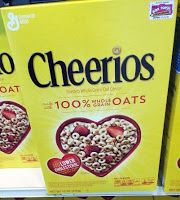Affirming a refusal to register the color yellow appearing on packaging for "toroidal-shaped, oat-based breakfast cereal," the TTAB found that the alleged mark lacks acquired distinctiveness and therefore fails to function as a trademark. Although Applicant General Mills submitted voluminous evidence to support its claim of acquired distinctiveness, the Board was convinced by proof of third-party use of yellow packaging for cereal products, that consumers "do not perceive the color yellow as having source significance for the goods." In re General Mills IP Holdings II, LLC, Serial No. 86757390 (August 22, 2017) [precedential] (Opinon by Judge Anthony R. Masiello).

Of course, a single color can never be inherently distinctive as a source indicator. Wal-Mart Stores, Inc. v. Samara Bros., 529 U.S. 205, 54 USPQ2d 1065, 1068 (2000) (citing Qualitex Co. v. Jacobson Prods. Co., 34 USPQ2d 1161, 1162-3 (1995). Moreover, "[b[y their nature color marks carry a difficult burden in demonstrating distinctiveness and trademark character." In re Owens-Corning Fiberglas Corp., 227 USPQ 417, 424 (Fed. Cir. 1985)

In light of the evidence of staggering promotional and sales
revenues, the Board recognized that General Mills "has worked
assiduously to create an association between the color yellow and
its 'regular' CHEERIOS brand cereal." The Board
observed, however, that "no matter how hard a company attempts
to make an inherently nondistinctive word or symbol serve as a
unique source identifier, it is proof of results—that
consumers so perceive the purported mark—that is the
touchstone of our inquiry into acquired distinctiveness.
E.g., Plastilite Corp. v. Kassnar Imps., 508 F.2d
824, 184 USPQ 348, 350 (CCPA 1975)."
Examining Attorney Tasneem Hussain based the refusal to register
primarily on a lack of substantially exclusive use of the color
yellow by General Mills. The evidence showed that General Mills
"is not alone in offering oat-based cereal, or even
toroidal-shaped, oat-based cereal, in a yellow package."
Moreover, the presence in the market of yellow-packaged cereals
from various sources – even cereals that are not made of oats
or are not toroidal in shape – further undermined any
possible source significance for the color yellow.
When customers see a color appearing on products from many different sources, they are less likely to expect the color to point to a single source of goods. Instead, customers are likely to perceive the color on packages as a device designed to make the packages attractive and eye-catching. This is especially true of a primary color, like yellow, which is used by many merchants and is not 'a color that in context seems unusual.' Qualitex, 34 USPQ2d at 1162-63.
General Mills pointed to its survey evidence purporting to show
that 48.3% of respondents associated the yellow box with the
CHEERIOS brand. The Board, however, saw a hole in the survey,
namely that the wording of the survey questions suggested that the
respondents could name only one brand: after being shown a drawing
of the applied-for mark, the respondents were asked, "If you
think you know, what brand of cereal comes in this box?"
Because General Mills failed to demonstrate that the yellow
background has acquired distinctiveness under Section 2(f), the
Board found that the applied-for mark fails to function as a
trademark for applicant's cereal.
TTABlog comment: What do you think? Did General
Mills recognize the problem of different types of cereals using a
yellow background, which caused it to identify goods as toroidal
and oat-based?
The content of this article is intended to provide a general guide to the subject matter. Specialist advice should be sought about your specific circumstances.

